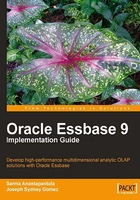
上QQ阅读APP看书,第一时间看更新
A typical network setup
In the following diagram, we show you a high-level image of the Essbase installation you have just completed. This is a very typical set up for most operations.

To help you understand and recognize your creation, the network diagram is divided into four sections which are explained below:
- Raw data: Loading data from a little to a lot is easy in Essbase. Data can be sent directly to the database using the "Lock and Send" feature of the Oracle Essbase Add-in for Microsoft Excel. Flat files received from other systems can be easily rendered Essbase-friendly, using convenient and easy to use data load rules. Finally, vast amounts of data can be loaded using SQL data load rules that interface directly with relational databases.
- The Essbase server: Running on the Essbase server is also something known as the Essbase agent. Depending on your needs, it is always best to try and use a dedicated server for your Essbase service. But don't worry, if that's not possible, we've found that Essbase does integrate nicely with other applications that have been installed.
- The developer client: This is on the desktop workstation that EAS is installed on. You will also want to have Microsoft Excel and the Oracle Essbase Add-in for Microsoft Excel installed on this machine as well. A setup like this allows the developer to quickly create and test many pieces of an Essbase application, such as calculation results, data load validations, and so on.
- End-user PC: This is your typical networked workstation that has decent computing power and storage. Having Microsoft Excel and the Oracle Essbase Add-in for Microsoft Excel installed are all that is necessary to provide the end-user with an extremely capable analysis and reporting tool.